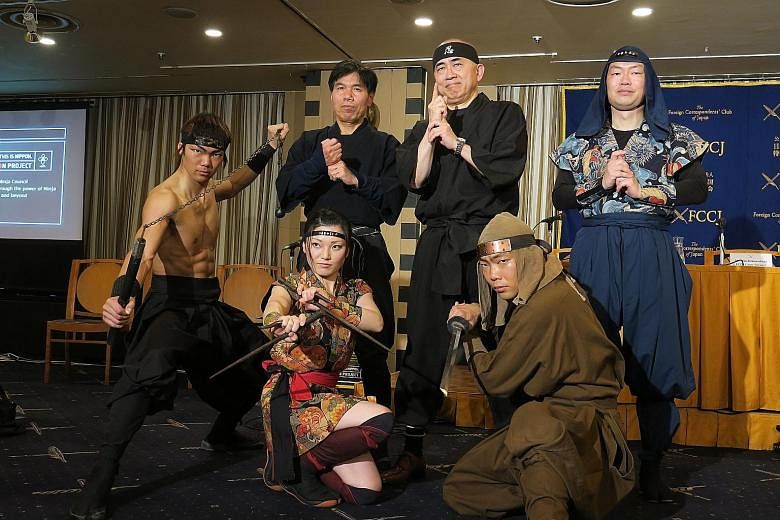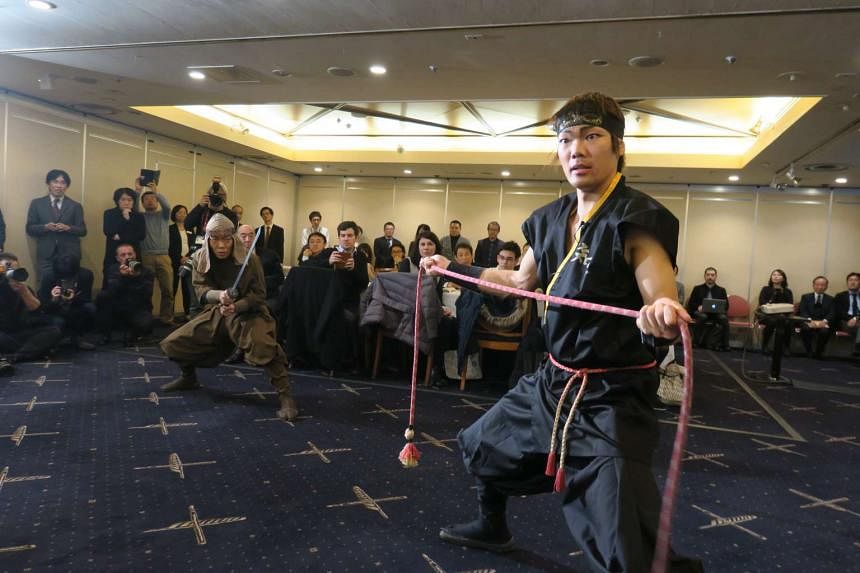The stealthy ninja spies of Japan's feudal era are making a very public comeback for modern times. The country is tapping its rich tradition to woo tourists ahead of the 2020 Tokyo Olympic Games.
The Ninja Nippon Project was launched yesterday to promote these martial arts masters and assassins. It will include new initiatives such as a ninja academy, a ninja museum, and tours to regions that are steeped in ninja history.
These areas include Ueda in Nagano prefecture, Koka in Shiga prefecture, Ureshino in Saga prefecture, Odawara in Kanagawa prefecture and Iga in Mie prefecture.
Feb 22 is known as Ninja Day as it reads 'ni, ni, ni' in Japanese.
The project comes under the Japan Ninja Council (JNC), which is led by 10 prefectural governors and city mayors. It will also launch official merchandise, including an origami set of shuriken - star-shaped daggers thrown by ninjas as weapons.
"The ninja embodies the traditional Japanese spirit, culture and sense of values such as peace, loyalty, technique, intelligence, diligence and endurance," said JNC vice-chairman Hiroshi Mizohata at a news conference. "This is known not only in Japan, but has spread all around the world through anime and films."
-
About ninjas
The Japan Ninja Council has issued a guidebook in English on the feudal martial arts warrior, as part of the Ninja Nippon Project. Here are some facts:
Q How did one become a ninja?
A It was, by and large, a hereditary job. Training began when children started speaking, and the more talented began their duties when they were as young as 12 years old.
Q What did ninjas eat?
A Low-fat, high-protein food. These included grains like millet, as well as pickled plums, boiled radish and tubers, and tofu. Their weight limit was 60kg.
Q How high and far can ninjas leap?
A They could jump as high as 2.7m and as far as 5.4 m.
Q What did ninjas wear?
A They dressed like farmers so as to not draw suspicion, preferring dull colours like navy blue and dark orange.
They also wore a face mask. Black clothes were avoided as they "project an outline when light is shone on it".
Q Was there a retirement age?
A No, they stepped down when they could no longer perform their physical duties. They would go on and train the next generation.
Walter Sim
The ninja museum is scheduled to be launched in Tokyo next year, in partnership with the Igaryu Museum in Iga city that already draws more than 200,000 visitors a year - 15 per cent of them from abroad.
There will also be regional tours allowing tourists to go to multiple cities within a period of time, and tours in which tourists will live and breathe the culture of one region.
A ninja academy to train individuals will also be launched under the watchful eye of Mr Jinichi Kawakami. Widely known as Japan's "last ninja", he is the only surviving heir to the ninjutsu school of martial arts techniques used in espionage.
Also leading the academy is Dr Yuji Yamada, who researches on ninja history and traditions as a humanities don at Mie University.
Mr Kawakami, who is the 21st head of the Ban clan of secret ninjas with a history of 500 years, said: "The art of ninja is made up of various elements, such as combat, survival techniques and astronomy."
But he is upfront in saying the academy will not pass down his full set of traditional ninjutsu skills.
"When you talk about learning ninjutsu, the original, actual traditional techniques can no longer be learnt. I myself have learnt them, but those are impossible to pass on," said Mr Kawakami yesterday. "What we hope to offer, from now on, are opportunities to gain a partial understanding of the various elements that make up ninjutsu."
He did not elaborate on the reasons yesterday, but has said in previous interviews that he decided to let the anachronistic art die with him. "We can't try out murder or poisons. Even if we can follow the instructions to make a poison, we can't try it out," he earlier said.
Yesterday he added: "The original ninjas themselves were known as shinobi, and these shinobi no longer exist. What we aim to do is to move from the traditional shinobi to the modern-day ninja."
•Visit https://ninja-official.com for more information.



